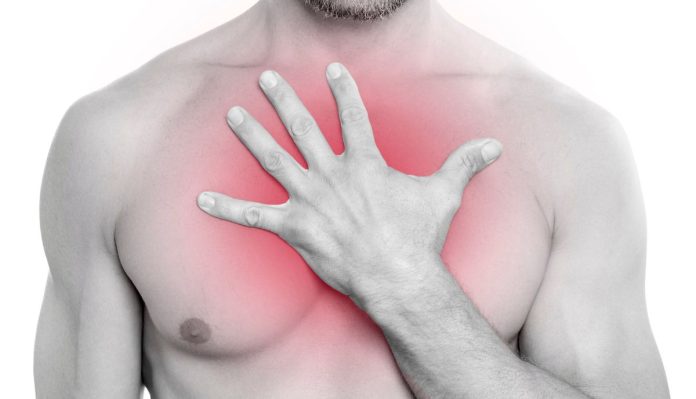Dips are a popular exercise for building strength and size in the chest, shoulders, and triceps. While they are an effective exercise, they can also be damaging if performed incorrectly or with too much weight. In this article, we’ll take a look at what dips are, why they can hurt the chest, and how to avoid common mistakes.
Definition of Dips
Dips are a compound exercise that targets the chest, shoulders, and triceps. This exercise is performed by leaning forward and lowering your body between two parallel bars. You then press your body up and return to the starting position. Dips are a great way to build strength and size in the chest and arms, and can be performed with or without additional weight.
Overview of Why Dips Can Hurt the Chest
The chest is a complex group of muscles that are used for a variety of activities. As such, it is important to be mindful of the amount of weight and angle of the body when performing dips. If done incorrectly, dips can place too much stress on the chest and lead to pain or injury. Common causes of chest pain when performing dips include:
- Using too much weight
- Performing dips at too steep of an angle
- Not engaging the core muscles
- Not keeping the elbows tucked in
In addition, dips can also cause shoulder pain due to incorrect form or overloading the shoulder joints. To reduce the risk of shoulder pain, be sure to keep your elbows tucked in, not flare them out too much, and don’t lean forward too much.
Anatomy of the Chest
When it comes to building a strong, muscular chest, dips are a great exercise to include in your workout routine. Not only do they target the chest muscles, but they also help to strengthen the arms and shoulders as well. To get the most out of your dips, it is important to understand the anatomy of the chest and the muscles involved in the exercise.
The chest consists of two main muscles: the pectoralis major and the pectoralis minor. The pectoralis major is the larger of the two and is responsible for most of the movement of the chest. It originates from the sternum and attaches to the humerus (upper arm bone). When it contracts, it brings the arms closer together and helps to flex the shoulder joint.
The pectoralis minor is a smaller muscle that originates from the ribs and attaches to the scapula (shoulder blade). It helps to stabilize the shoulder joint and is also responsible for adduction and abduction of the arm. When it contracts, it pulls the shoulder blade forward and helps to keep the shoulder joint in proper alignment.
When doing dips, both of these muscles are worked. As you lower your body towards the ground, the pectoralis major is used to slow your descent. As you push back up, the pectoralis minor is used to help return you back to the starting position. Both muscles are important for dips and for overall chest strength.
In addition to the pectoralis major and minor, the dip exercise also works other chest muscles such as the serratus anterior, subscapularis, and the trapezius. The serratus anterior helps to stabilize the shoulder blades and allows for greater abduction of the arm. The subscapularis helps to stabilize the shoulder joint and is responsible for adduction of the arm. Finally, the trapezius helps to stabilize the shoulder blades and aids in the downward motion of the dip.
Common Causes of Chest Pain During Dips
Chest pain during dips is a common occurrence for many weightlifters and gym goers. While it is important to recognize the symptoms and address them, it is also important to understand the causes behind the chest pain.
Poor Form
One of the most common causes of chest pain during dips is poor form. Many people will overstretch their arms and shoulders, strain their chest muscles, and even put too much pressure on their wrists and elbows. This can lead to chest pain and, in some cases, even injury. To prevent this from happening, it is important to maintain good form during dips. This means keeping your elbows close to your body and your shoulders tucked back. Additionally, make sure to keep your wrists and elbows relaxed.
Overloading the Chest Muscles
Another common cause of chest pain during dips is overloading the chest muscles. This is especially common among beginner lifters who may be using too much weight or performing too many reps. When the chest muscles become overloaded, it can cause chest pain and tightness. To prevent this from happening, it is important to start slow and gradually increase the weight and reps as you gain strength.
Activating Other Muscles
Another cause of chest pain during dips is activating other muscles. This can happen if you are not focusing on engaging the chest muscles and are instead relying on other muscles to do the work. You should focus on engaging the chest muscles and squeezing them to target the right muscles during dips.
Increase in Intensity
Finally, chest pain during dips can be caused by an increase in intensity. If you are pushing yourself too hard and going too fast, this can cause chest pain and discomfort. To prevent this, it is important to take your time and slowly increase the intensity as you progress.
How to Avoid Chest Pain During Dips
Chest pain during dips can be a common problem for many weightlifters. It’s important to understand the causes of this pain and what you can do to prevent or alleviate it. Here are some tips to help you avoid chest pain during dips:
Proper Form
When performing dips, make sure that you maintain good form throughout the exercise. Keep your elbows tucked in to your sides, chest up, and shoulders back. This will help to ensure that the chest is getting the proper amount of stress during the exercise and help you avoid any chest pain.
Warm-up
Before you begin doing dips, it’s important to warm up your muscles and joints. Do some light jogging or dynamic stretching to get your body loose and flexible before you start your dips.
Lower the Intensity
If you’re finding that the dips are causing chest pain, try lowering the intensity. This can be done by reducing the weight or the number of reps.
Use Assistance
If you’re still having trouble with chest pain, consider using an assistance tool like a dip belt or a spotter. These tools can help provide extra support and help you complete the exercise without too much strain on the chest.
Add Variation
Finally, if you’re still experiencing pain, try adding some variation to your dips. You can do this by performing different types of dips, such as decline dips or inverted dips.
Conclusion
In conclusion, chest pain during dips can be caused by a variety of factors, such as improper form, technique, and lack of a proper warm-up. To prevent chest pain, it is important to ensure that proper form and technique are used, and that a warm-up is completed prior to performing the exercise. By following these simple steps, you can safely perform dips and avoid chest pain and other injuries.

